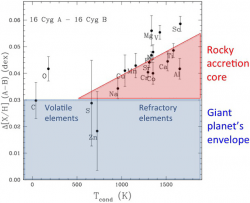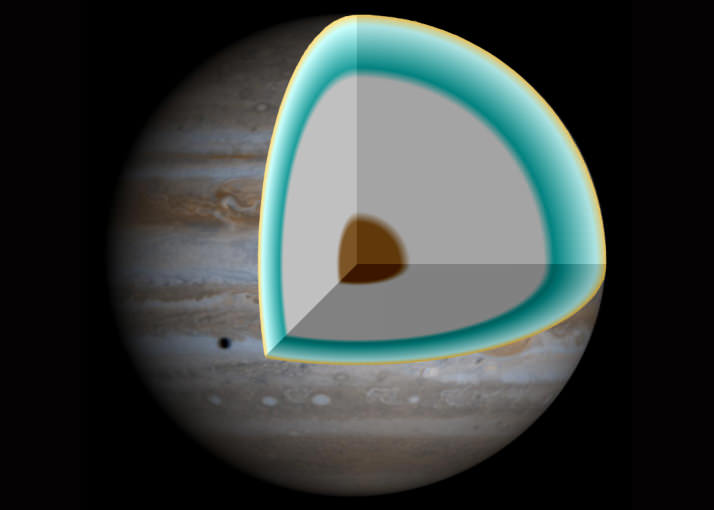It’s likely that Jupiter-like planets’ origins root back to either the rapid collapse of a dense cloud or small rocky cores that glom together until the body is massive enough to accrete a gaseous envelope.
Although these two competing theories are both viable, astronomers have, for the first time, seen the latter “core accretion” theory in action. By studying the exoplanet’s host star they’ve shed light on the composition of the planet’s rocky core.
“Our results show that the formation of giant planets, as well as terrestrial planets like our own Earth, leaves subtle signatures in stellar atmospheres”, said lead author and PhD student Marcelo Tucci Maia from University of São Paulo, Brazil, in a press release.
Maia and colleagues pointed the 3.5-meter Canada-France-Hawaii Telescope toward the constellation Cygnus, in order to take a closer look at two Sun-like stars in the distant 16 Cyg triple-star system. Both stars, having formed together from the same gaseous disk over 10 billion years ago and having reached the same mass, are nearly solar twins.
But only one star, 16 Cygni B, hosts a giant planet. By decomposing the light from the two stars into their wavelengths and looking at the difference between the two stars, the team was able to detect signatures left from the planet formation process on 16 Cygni B.
It’s the perfect laboratory to study the formation of giant planets.

Maia and colleagues found that the star 16 Cygni A is enhanced in all chemical elements relative to 16 Cygni B. Hence, the metals removed from 16 Cygni B were most likely removed from the protoplanetary disk in order to form the planet.
On top of the overall deficiency in all elements, 16 Cygni B has an added deficiency in the refractory elements — those with high condensation temperatures that form dust grains more easily — such as iron, aluminum, nickel, magnesium, scandium, and silicon. This helps verify what astronomers have expected all along: rocky cores are rich in refractory elements.
The team was able to decipher that these missing elements likely created a rocky core with a mass of about 1.5 to 6 Earth masses, which is similar to the estimate of Jupiter’s core.
“16 Cyg is a remarkable system, but certainly not unique,” said coauthor Ivan Ramírez from the University of Texas. “It is special because it is nearby; however, there are many other binary stars with twin components on which this experiment could be performed. This could help us find planet-host stars in binaries in a much more straightforward manner compared to all other planet-finding techniques we have available today.”
The results were accepted for publication in The Astrophysical Journal Letters and are available online.


Nice!
This may be better constraints on the process. But FWIW I’ve seen observational constraints for only core accretion before:
“Thus, cloud of planets residing to the right of the ‘‘rocky’’
dashed line in Fig. 5 support a model of exoplanet structure with
both rock and volatiles. These planets have larger radii (and
volumes) than can be explained by a purely rocky interior.
Therefore, these planets surely contain large amounts of gas and
ices to account for their large size, given their mass. Clearly, the
planets larger than 2 R ? are composed of large contributions of
gas in addition to any rocky core.
A core-envelope model follows from the expectation that the
more dense material will sink (differentiate) toward the center of
the planet. The argument presented here for large amounts of
low-density material on a rocky core does not make use of any
theoretical equation of state.”
[Occurrence and core-envelope structure of 1–4× Earth-size planets around Sun-like stars – Geoffrey W. Marcy et al, PNAS 2014; http://www.pnas.org/content/early/2014/05/21/1304197111.full.pdf ; my bold]
And how would a stellar material collapse happen after the fact?
Wouldn’t it be much simpler to have a DVD style protosystem which got pinched (between hole and edge). With the rotation of the matter falling into the pinch (the protostar) until a cutoff rate? (And the remainder of the DVD would be ending up as a second star down to a Jupiter sized planet)
This would mean that two similar stars can originate from two different disks. This would also be simple enough to show how supermassive stars can keep on accumulating matter for longer than current models.